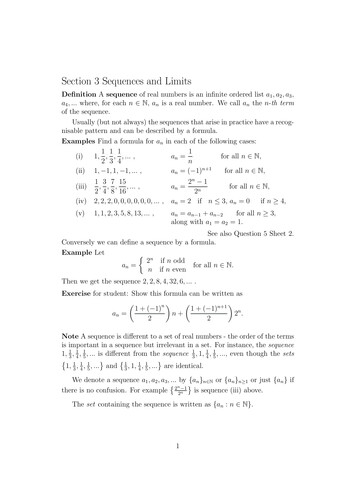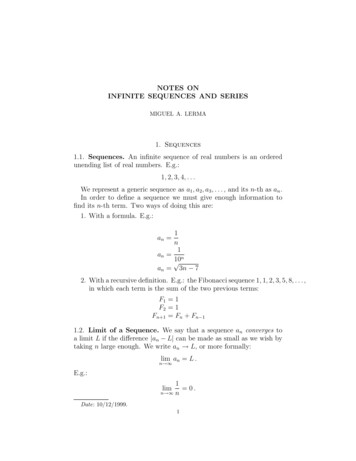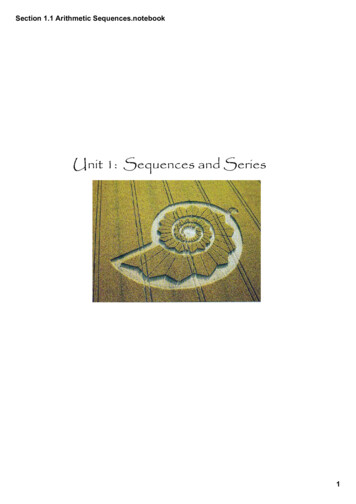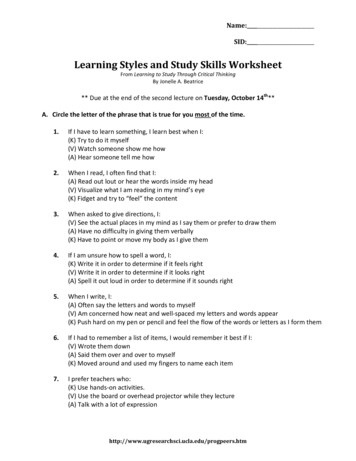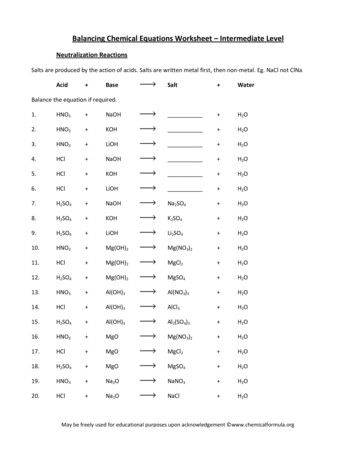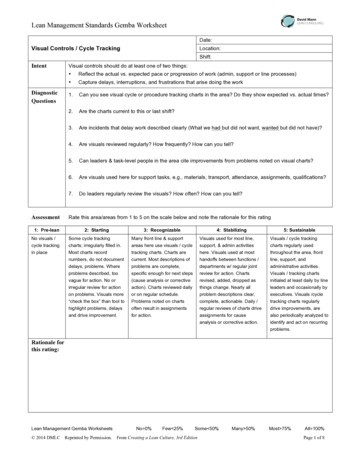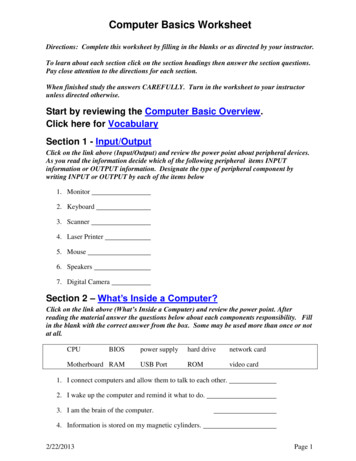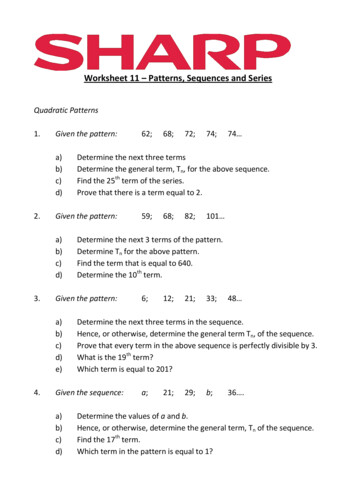
Transcription
Worksheet 11 – Patterns, Sequences and SeriesQuadratic Patterns1.Given the pattern:a)b)c)d)2.3.4.74;74 59;68;82;101 6;12;21;33;48 Determine the next three terms in the sequence.Hence, or otherwise, determine the general term Tn, of the sequence.Prove that every term in the above sequence is perfectly divisible by 3.What is the 19th term?Which term is equal to 201?Given the sequence:a)b)c)d)72;Determine the next 3 terms of the pattern.Determine Tn for the above pattern.Find the term that is equal to 640.Determine the 10th term.Given the pattern:a)b)c)d)e)68;Determine the next three termsDetermine the general term, Tn, for the above sequence.Find the 25th term of the series.Prove that there is a term equal to 2.Given the pattern:a)b)c)d)62;a;21;29;b;36 .Determine the values of a and b.Hence, or otherwise, determine the general term, Tn of the sequence.Find the 17th term.Which term in the pattern is equal to 1?
5.Given the sequence:a)b)c)d)6.a;-2;b;-2;4 .Determine the values of a and b.Hence, or otherwise, determine the general term, Tn, for the abovepattern.Determine which term is equal 68.What are the two consecutive odd numbered terms that when addedtogether give the value of 320?On a certain long road with many robots, the municipality switches the robotsto red and green in the following pattern:1 Red;2 Green;1 Red;3 Green;1 Red;5 Green;1 Red;8 Green and so on a)If the pattern continues, determine how many green lights will be on inthe 11th section of green lights?b)If the average distance between the robots is 150m, determine how faryou would have driven if you started at the first robot and finished afterthe 23rd green robot before the next red robot.Arithmetic Sequences and Series7.Given the series:a)b)c)d)e)8.10 18 26 34 Determine the first term, a, and the difference, d, of the above series.Determine whether 100 is a part of the series.Determine the 17th term.Determine the sum of the first 10 terms.Determine the sum of the values between term 11 and term 20.Given the series:7 9 10 12 .a)b)Determine the general term for the above series.Determine the 14th term.c)Which term is equal to 22 ?d)Determine the sum of the first 20 terms.e)Determine n if Sn 590
9.Given that the following sequence is an arithmetic series: 1; 2; 2 a)b)c)d)e)10.Given that the following sequence is an arithmetic series:3 2 ; 3; 3 a)b)c)d)11.Determine the value of p and hence the first three terms of thesequence.Hence, or otherwise, determine the general term, Tn, in terms of n.Find the 15th term.Find the sum of the first 16 terms.Given that an arithmetic sequence has a 6th term equal to 39 and a 10th termequal to 83, determine:a)b)c)d)e)12.Determine the value of p.Hence, or otherwise, determine the first term and the commondifference.Find the 11th term.Find the sum of the first 21 terms.Find n if Sn 286.The first term and the common difference.The 9th term.The sum of the first 19 terms.The term which is equal to 127n when Sn 4 305.Given that an arithmetic sequence has a fourth term equal to 7 and a ninthterm equal to 57, determine:a)b)c)d)e)the first term and the common differencethe terms between the fourth and ninth terms.The sum of the first 18 terms.The sum of the terms between term 9 and term 18.n if Sn 384
13.Given that the arithmetic sequence with the 6th term equal to 27 and the sumof the first 12 terms is equal to 504, determine:a)b)c)d)Determine the first term and the common difference for the series.The 8th term.The sum of the first 17 terms.n if Tn 357.Geometric Sequences and Series14.Given the geometric series:a)b)c)15.16.6 30 150 750 Determine the general term for the above series.Determine the sum of the first 8 terms.Is the series converging or diverging? Give a reason for your answer.Given the following geometric series: 1 a)b)c)d)e)Determine the general term, Tn, in terms of n.Determine the sum of the first 12 terms.Determine the sum of the first 50 terms.Is the series converging or diverging? Give a reason for your answer.Determine the sum to infinity.f)Find n if Tn .Given the following geometric series: 14 21 31 47 a)b)c)d)Determine the general term Tn in terms of n.Determine the 8th term in the series.Determine the sum of the first 16 terms.Is this series a converging or diverging series? Give a reason for youranswer.e)Determine n if Sn 450
17.Given that the following sequence is geometric: 1;a)18. b)c)d)Determine the value of p, and hence the first term and the commonratio.Hence, determine the first three terms.Determine the 7th term.Determine the sum of the first 10 terms.e)Which term is equal tof)Determine the sum to infinity.?Given that the following series is geometric: 4; 2 2; 9 1; a)b)c)d)19.;Determine the value of p if 0, and hence the values of the firstthree terms.Determine the sum of the first 10 terms.Which term is equal to 327 680?Determine the value of n if Sn 1 705.In a certain geometric series the third term is and the 6th term is.Determine:20.a)b)c)d)Determine the first term and the common ratio.Determine the 8th term.Determine the sum of the first 11 terms.Is this a converging or diverging series? Give a reason for you answer.e)Determine n if In a certain geometric series the 5th term is equal toequal toa)b)c)d). Determine:Determine the first term and the common ratio.Determine the 7th termDetermine the sum to infinity if possible.Find n if Sn 13,4159.and the 4th term is
Mixed Questions21.Given the following sequence which is both arithmetic and geometric:5; 2!; " Determine the values for ! and ".22.Given that the first term of an arithmetic series is equal to the first term of ageometric series which is 2, that the 5th term of the arithmetic series is equalto the second term of the geometric series, and that the 8th term of thearithmetic series is equal to the 3rd term of the geometric series, determinethe first three terms of both the arithmetic and geometric series.23.Pruven is doodling on the back of his exam pad and comes up with thefollowing pattern:Diagram 1a)b)c)Diagram 2Diagram 3Diagram 4Determine whether the pattern is quadratic, arithmetic or geometric.Hence, or otherwise, determine the general term Tn in terms of n, forthe doodles.Every hexagon Pruven draws has a height of 1cm. If Pruven’s page hasheight of 15cm, how many hexagons would be in the doodle?
Worksheet 11 – Patterns, Sequences and Series Quadratic Patterns 1. Given the pattern: 62; 68; 72; 74; 74 a) Determine the next three terms b) Determine the general term, T n, for the above sequence. c) Find the 25 th term of the series. d) Prove that there is a term equal to 2.
